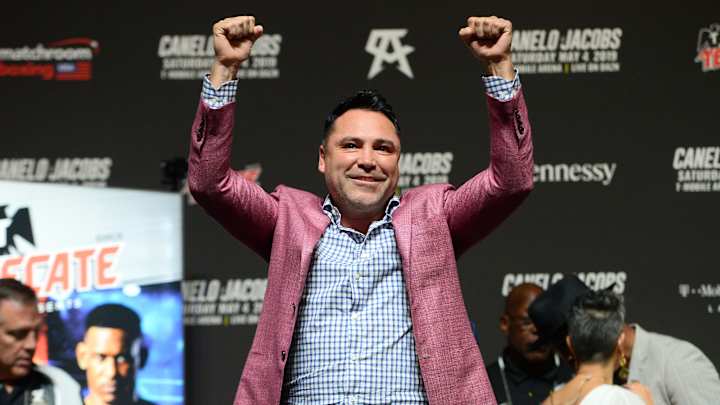Don’t Count on Oscar De La Hoya and Other Legends’ Comebacks to Save Boxing

In the same week 48-year old Oscar De La Hoya announced plans to return to the ring this summer, reports surfaced in Puerto Rico that 40-year old Miguel Cotto would dust off his gloves for an exhibition match with 47-year old Juan Manuel Marquez, while in Australia 41-year old Sakio Bika weighed in for Wednesday night's trilogy fight with 47-year old Sam Soliman.
Yes, old-guy boxing is a thing.
No, it doesn’t seem to be going anywhere.
Blame Triller, I guess, the music video app, which will stream De La Hoya’s announced return in July and breathed life into geriatric pugilism by backing Mike Tyson’s (exhibition) return against Roy Jones Jr., an event that generated nearly two million pay-per-view buys. De La Hoya—admittedly motivated by Tyson—is banking on his return being similarly successful. Tyson, 54, is planning a second exhibition bout in May, with 58-year-old Evander Holyfield among the potential opponents.
Retired fighters' getting the itch to return is nothing new. Sugar Ray Leonard retired four times before Hector Camacho sent a then 40-year old Leonard back for good. Ricky Hatton ended a three-year retirement in 2012, only to get knocked out by lightly regarded Vyacheslav Senchenko. For years rumors have persisted that aging retirees Floyd Mayweather, Wladimir Klitschko and Andre Ward could mount comebacks.
Exhibitions, though, have created a new lane for retired fighters, a chance to make a quick buck, with relatively minimal risk.
But why are they so popular? The truth is they are not ... yet. Tyson is popular. The ex-heavyweight champ is one of the most iconic figures in boxing history, a terrifying power puncher who spent the late 1980s pancaking every opponent put in front of him. When Tyson fought Jones, he drew in a blend of a generation of fans who remembered what he was and one that never got to see it. Years of becoming a prominent figure in pop culture have only enhanced Tyson’s appeal.
Will De La Hoya attract a similar audience? The Golden Boy spent the better part of two decades as one of boxing’s biggest stars. But smaller-weight fighters generally don’t have the same magnetic pull as heavyweights, at least not ones like Tyson. That’s why the interest likely won’t be as strong for De La Hoya’s return, especially if, as rumored, it comes against an MMA fighter in what would be little more than a glorified sparring session. The same can be said for Cotto-Marquez. Is there really a market for two faded ex-welterweights lacing them up?
Maybe. But that it’s even a possibility is a reflection of the current state of boxing. “It doesn’t say wonderful things about the state of today’s stars,” says Lou DiBella, a veteran boxing promoter and former executive at HBO. There is more than enough talent in boxing to catapult it back into the mainstream. Terence Crawford could fight Errol Spence. Ryan Garcia could face Gervonta Davis. Anthony Joshua could meet Tyson Fury (which, in fairness, is likely to happen at some point this year). There’s no legitimate reason boxing can’t regularly produce compelling matchups.
But it doesn’t, which has boxing fans gravitating toward the aging stars who once did. “Boxing is simply a subset of the sports business,” says DiBella, “which is a subset of the entertainment business. It’s popularity. It’s name recognition. Right now the most recognizable names are the ones who aren’t fighting. Other than Canelo [Alvarez] and Ryan [Garcia], there are not many guys who resonate outside of heavyweight.”
It’s true. And if De La Hoya, Cotto and any other '90s stars continue the trend of clobbering active fighters in pay-per-view sales, it will become embarrassing. Promoters will be faced with deferring key dates to exhibition matches. Fighters with sterling records will see viewership numbers dwarfed by boxers decades past their primes. “And it will be all their fault,” a longtime boxing official told Sports Illustrated. “You can’t get most of the top guys to fight anybody. Most of them sit on social media and brag about how much money they are making. They don’t give a f--- about legacies. Think anyone talks about most of these guys around watercoolers? If Oscar fights, people will be talking about it.”
Boxing has been on a steady decline since the 1980s, when the Four Kings—Leonard, Marvin Hagler, Roberto Duran and Thomas Hearns—ruled, when Tyson took center stage, when the sports world stopped for a megafight. Its free fall hasn’t shocked the sport into a correction. Blowback from the public hasn’t, either. Maybe the humiliation of washed up stars raking in pay-per-view dollars will. Though I wouldn’t count on it.

Chris Mannix is a senior writer at Sports Illustrated covering the NBA and boxing beats. He joined the SI staff in 2003 following his graduation from Boston College. Mannix is the host of SI's "Open Floor" podcast and serves as a ringside analyst and reporter for DAZN Boxing. He is also a frequent contributor to NBC Sports Boston as an NBA analyst. A nominee for National Sportswriter of the Year in 2022, Mannix has won writing awards from the Boxing Writers Association of America and the Pro Basketball Writers Association, and is a longtime member of both organizations.
Follow sichrismannix